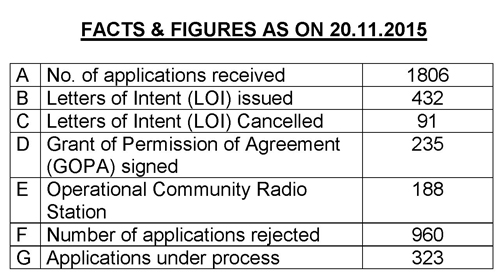

MUMBAI: Community radio stations have always been used as a tool to democratise information, create awareness and develop citizenship, particularly in the less developed urban areas and the countryside. Today, in the radio ecosystem, AIR is the forerunner when it comes to public service broadcaster, while private FM has joined the race. However, the one medium that not only has potential for being another pillar, is community radio, which is also perhaps the closest to a large number of people.
Unfortunately, this personalised mode of information is struggling to retain its power. It has been 13 years since India opened the door to community-run radio stations; however only 188 such stations are currently functional in the country, which makes one wonder why community radio is not growing?
Community Radio Association VP, and Radio Namaskar chairperson N A Shah Ansari explained, “If you look into the background of the radio ecosystem, the policy for community radio was made in 2002, but it was only by 2006 that the civil society got permission for people to start community radio stations. This means after that the number of applications increased thereafter. But since the process for acquiring a licence is so long, people are getting permission after three to four years of applying.”
In India, community radio has a leading edge over AIR and private FM, in terms of programming and reach, as it generally happens in the regional language. Additionally, it involves issues related to the lay man, allowing people from villages and small towns to relate to it. It also empowers smaller communities, enabling them to speak out and share information.
However, there are many problems which community radio faces, the most serious of these being scarcity of funds, and delay in grant of permission agreement (GOPA), all of which result in years before a community radio station can be set up in a particular region of the country.
Scarcity of funding does mean that small community radios generally operate with minimum equipment. These stations are also isolated due to shortage of transport and telephones. While cell phones are helping in some way, they can be expensive, and access to the internet is still a dream for people in many rural areas.
Despite all this, there is still a huge number of applications for community radio stations, which is proof that the medium is still very much alive. However, there is yet a lot to be done to ensure that more community radio stations are given the green light to become functional.
Explaining how these stations can be gradually increased Ansari said, “Single window license process will solve most of the problems; one organisation will apply with all the documents and within one period of time the organisation gets the license. During that time span, the Ministry can ask for more information and clarification. But the policy we currently have is not as efficient. People apply almost five times to get clearance, which is difficult and time consuming, resulting in many backing out. Inter ministerial committee and single monetary system can solve the problem.”
According to a recent report by the I&B Ministry, 960 applications for community radio licences have been rejected or withdrawn as of 15 November 2015.

Ansari further added, “There are many ministries which are involved, like Ministry of Information and Broadcast, Department of IT, educational institutions and Ministry of HRD, which makes the process complicated and so the policy does not work. As there is not communication and understanding between them, there is no single monitoring system that helps the MIB approve of licenses.”
Even after 10 years, there are only 188 community radio stations functioning against 4000 stations that were promised in 2007.
He also explained that as far as government expenditure on community radio goes, at least 10-15 lakhs is being spent on each consultancy. Apparently, Rs 100 crores has been sanctioned for community radio, but the money is going towards consultancy rather than focusing on sustainability and promoting community radio stations, which are struggling to survive.
More than 70 per cent of the Indian population lives in rural areas and a large number of these areas even have electricity. As radios are inexpensive and run on batteries or solar power, community radio stations are a better source of information. What is left to be seen is whether the government will use this medium, and what choice non-Hindi-speaking regions will have when it comes to information and awareness.